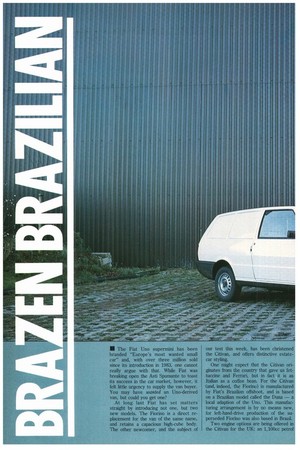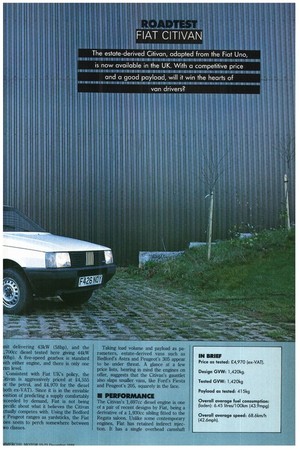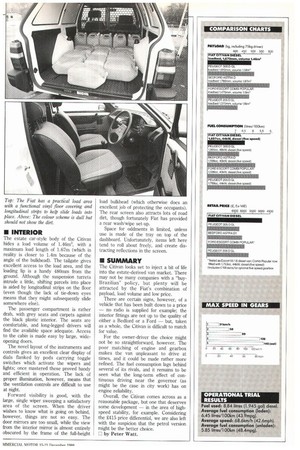• The Fiat Uno supermini has been branded "Europe's most
Page 36

Page 37

Page 38

Page 39

If you've noticed an error in this article please click here to report it so we can fix it.
wanted small car" and, with over three million sold since its introduction in 1983, one cannot really argue with that. While Fiat was breaking open the Asti Spumante to toast its success in the car market, however, it felt little urgency to supply the van buyer. You may have wanted an Uno-derived van, but could you get one?
At long last Fiat has set matters straight by introducing not one, but two new models. The Morino is a direct replacement for the van of the same name, and retains a capacious high-cube body. The other newcomer, and the subject of our test this week, has been christened the Citivan, and offers distinctive estatecar styling.
One might expect that the Citivan originates from the country that gave us fettuccine and Ferrari, but in fact it is as Italian as a coffee bean. For the Citivan (and, indeed, the Fiorino) is manufactured by Fiat's Brazilian offshoot, and is based on a Brazilian model called the Duna — a local adaption of the Uno. This manufacturing arrangement is by no means new, for left-hand-drive production of the superseded Fiorillo was also based in Brazil.
Two engine options are being offered in the Citivan for the UK: an 1,100cc petrol nit delivering 43kW (58hp), and the ,700cc diesel tested here giving 44kW 60hp). A five-speed gearbox is standard srith either engine, and there is only one rim level.
Consistent with Fiat UK's policy, the ;itivan is aggressively priced at £4,555 m the petrol, and £4,970 for the diesel both ex-VAT). Since it is in the enviable losition of predicting a supply comfortably xceeded by demand, Fiat is not being pecific about what it believes the Citivan ctually competes with. Using the Bedford r Peugeot ranges as yardsticks, the Fiat oes seem to perch somewhere between wo classes. Taking load volume and payload as parameters, estate-derived vans such as Bedford's Astra and Peugeot's 305 appear to be under threat. A glance at a few price lists, bearing in mind the engines on offer, suggests that the Citivan's gauntlet also slaps smaller vans, like Ford's Fiesta and Peugeot's 205, squarely in the face.
NI PERFORMANCE
The Citivan's 1,697cc diesel engine is one of a pair of recent designs by Fiat, being a derivative of a 1,930cc sibling fitted to the Regata saloon. Unlike some contemporary engines, Fiat has retained indirect injection. It has a single overhead camshaft driven by a toothed belt and, with a 20.5:1 compression ratio, generates 44kW at 4,500rpm with 103Nrn (75.916ft) of torque at 3,000rpm.
Fiat has apparently devoted a lot of attention to developing engine mounts and sound-deadening material to contain vibration and noise but, despite this, the refinement of engine is disappointing for such a new design. When starting one is left in little doubt about which pump to choose at the petrol station and, particularly when cold, tickover is noisy and throttle response very sluggish indeed.
Once warmed up and moving matters improve: the Citivan is at its best cruising quietly and smoothly on the motorway. Hard acceleration, however, is accompanied by a deep growl from under the bonnet which becomes tiresome, while the gear lever agitates in the palm like a schoolchild waiting to be excused. A particularly harsh resonance is also apparent at one point in the rev range, equating to an indicated 105-1081cm/h in fifth gear.
Highlighting these matters might not be necessary were it not for two factors: the engine's lack of low-down torque (witness the high speed of peak torque for a diesel of 3,000rpm), and the poorly-chosen gear ratios. These conspire to dictate a driving style which does nothing to disguise the engine's unruliness.
For the van driver in a hurry (and which van driver is not?) acceleration takes on a familiar pattern. First and second gears, which are low and close together, are consumed in a roar to the redline (or in this case to the governor, since no tachometer is fitted). Once in third, it's foot to the floor until cruising speed is reached, when overdriven fourth (or fifth) can be selected. If fourth gear is chosen before 80km/h the torque deficiency dictates that there is little acceleration, while the engine shakes noisily on its mountings in protest.
Ignoring noise levels and using plenty of revs, however, does provide reasonable performance, even when fully laden, and motorway speed can be maintained with only the occasional recourse to fourth gear on steep inclines.
The gearchange can be vague and obstructive, particularly in the top three gears, which does not help when trying to keep the engine in its power band. Fiat should also consider a detent for reverse gear, since selecting reverse when changing from fifth to fourth could happen; when decelerating from motorway speeds a missed change can be distracting. The clutch engaged smoothly, but might be sprung too stiffly for some tastes.
• HANDLING
Under most road conditions the Citivan handles well, with little body roll and sensibly-weighted steering giving a good feel of the road (despite being a little "dead" in the straight-ahead position), while the generous 165/70 tyres contribute to good road holding. Low-speed manoeuvring requires rather too much effort from the driver, while at the opposite end of the scale, a more disturbing characteristic is evident. During high-speed cruising — particularly when fully laden — the Citivan suffers from what appears to be rear-wheel steering. This is initiated by a variation in the load on the wheels, which can be in the form of a steering movement, a bump, or a strong gust of wind.
The movement, which is caused by insufficient location of the rear wheels, is not inherently dangerous, and requires no steering correction. The feeling in the seat of the pants is an unpleasant one, however, and when circulating a dark and rainswept M25 the suspicion that ball bearings have been substituted for the rear wheels does little to inspire driver confidence. Owners should also ensure that tyre pressures are at the appropriate level when a load is added, or the problem can be exacerbated.
Ride comfort in the Citivan is satisfactory although, even when loaded, the Fiat's suspension does not have the suppleness which is a charactistic of many French-designed vehicles, for instance.
A plus point for the Citivan is the excellent brakes, which are capable of stopping the vehicle swiftly and safely from speed. The pedal has a moderate degree of servc assistance, and allows the driver to control the stopping power as required. The handbrake is not so impressive, and k barely able to hold the vehicle facing up E 25% (1-in-4) gradient.
• ECONOMY
Perhaps because of the driving style im. posed by engine and gearbox, the Citivar recorded slightly disappointing fuel con sumption figures over our light van tes route. Loaded to its 490kg limit (includint a 75kg driver), the Fiat consumed 6.4f litres/100km (43.9mpg) at an averag( speed of 68.6Icrn/h (42.6mph). Unladen this improved to 5.85 litres/100kn (48.4mpg).
While in absolute terms these are re turns that most owners would be happ: with, one need only look at the competi tion to put the figures into context. Bed ford's 1,598cc Astra diesel returned 5.8 litres/100km (48.2mpg) carrying a large 594kg load, and in the smaller class Peugeot's 205 scored 5.29 litres/100kr (53.3mpg) from its 1,769cc diesel with 405kg payload (both vans maintaine roughly the same speed as the Fiat, an were fitted with a five-speed gearbox).
When it comes to servicing, the Fu diesel may be relatively unfamiliar to som dealers, although it has been available i the Uno saloon for about a year.
For those attempting their own maint( nance, access to certain items could b improved, for space is limited.
To work on the fuel filter, the injectio unit, the alternator and the fan belt, appears that the hapless owner will hay to work from below. Top: The Fiat has a practii al load area with a functional vinyl floor covering and longitudinal strips to help slide loads into place. Above: The colour scheme is dull but should not show the dirt.
• INTERIOR
The estate car-style body of the Citivan hides a load volume of 1.460, with a maximum load length of 1.67m (which in reality is closer to 1.4m because of the angle of the bulkhead). The tailgate gives excellent access to the load area, and the loading lip is a handy 480mm from the ground. Although the suspension turrets intrude a little, shifting parcels into place is aided by longitudinal strips on the floor (even though the lack of tie-down eyes means that they might subsequently slide somewhere else).
The passenger compartment is rather drab, with grey seats and carpets against the black plastic interior. The seats are comfortable, and long-legged drivers will find the available space adequate. Access to the cabin is made easy by large, wideopening doors.
The novel layout of the instruments and controls gives an excellent clear display of dials flanked by pods carrying toggle switches which activate the wipers and lights; once mastered these proved handy and efficient in operation. The lack of proper illumination, however, means that the ventilation controls are difficult to use at night.
Forward visibility is good, with the large, single wiper sweeping a satisfactory area of the screen. When the driver wishes to know what is going on behind, however, things are not so easy. The door mirrors are too small, while the view from the interior mirror is almost entirely obscured by the frame of the full-height load bulkhead (which otherwise does an excellent job of protecting the occupants). The rear screen also attracts lots of road dirt, though fortunately Fiat has provided a rear wash/wipe set-up_ Space for oddments in limited, unless use is made of the tray on top of the dashboard. Unfortunately, items left here tend to roll about freely, and create distracting reflections in the screen.
• SUMMARY
The Citivan looks set to inject a bit of life into the estate-derived van market. There may not be many companies with a "buyBrazilian" policy, but plenty will be attracted by the Fiat's combination of payload, load volume and low price.
There are certain signs, however, of a vehicle that has been built down to a price — no radio is supplied for example; the interior fittings are not up to the quality of either a Bedford or a Ford — but, taken as a whole, the Citivan is difficult to match for value.
For the owner-driver the choice might not be so straightforward, however. The poor matching of engine and gearbox makes the van unpleasant to drive at times, and it could be made rather more refined. The fuel consumption lags behind several of its rivals, and it remains to be seen what the long-term effect of continuous driving near the governor (as might be the case in city work) has on engine reliability.
Overall, the Citivan comes across as a reasonable package, but one that deserves some development — in the area of highspeed stability, for example. Considering the £415 price differential, we are also left with the suspicion that the petrol version might be the better choice.
CI by Peter Watt.










































































